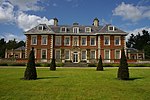Highnam is a village and civil parish on the outskirts of the city of Gloucester. It is three miles northwest of the city on the A40, on the way to Ross, west of Alney Island and Over Bridge. It is connected by Segregated Bicycle Paths via Over Bridge and Alney Island to Gloucester. The parish includes the villages of Lassington and Over. In the 2001 census the parish had a population of 2,014, reducing to 1,916 at the 2011 census.Highnam was originally made up of farm land, which explains some of its street names (Brimsome Meadow, Poppy Field, Stoney Field, Long Field, Peters Field, Williams Orchard, et al.). As a village, Highnam is fairly small, containing few social amenities. These include the Church of the Holy Innocents, a school (Highnam C of E Primary), a village hall, a day nursery, a village shop and a doctor's surgery.
The Arnold family were Lords of the Manor in the sixteenth century- the best known member of the family is Sir Nicholas Arnold (died 1580), Lord Deputy of Ireland.
The wealthy artist and collector Thomas Gambier Parry purchased the Highnam Court estate in 1837. He remodelled the Court and laid out the Highnam Court gardens; he was one of the first to make a pinetum. Highnam Court gardens are now open to the public. His son, the composer Hubert Parry, learnt to play the organ in the church.
Highnam has an eighteen-hole golf course and a large business park just outside the main village. The village is home to both football and cricket teams Highnam Court Cricket Club and also has Beavers, Cubs, Scouts and Brownies groups. A new feature in 2007 was the addition of a Youth Café.
Highnam Woods to the west of the village are managed by the RSPB as a nature reserve, and Lassington Wood is to the east of the village.









